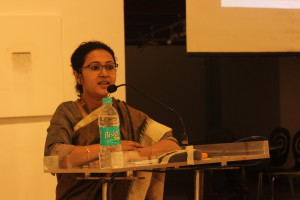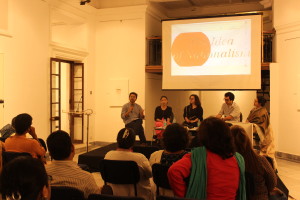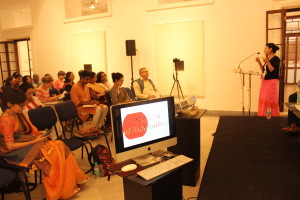Keynote address
The 1960s: Thinking Beyond Borders
Malini Sur
Malini Sur is a senior research fellow at the Institute for Culture and Society, Western Sydney University.
In 1964 Karim Naseer was arrested as a spy and deported to East Pakistan. He was a farmer hailing from Assam who lived out the rest of his life in present Bangladesh, coming to the border every day to stare into the distance at the direction of the hills he called home. In her keynote for the day Malini Sur spoke of the shifting geographical lines between Bengal and Assam and nationalist perspectives which flattened the difference between farmers, refugees and criminals, the criminalisation of the former two varying depending on the erstwhile powers that be. Even as the Hajongs of Assam were communist revolutionaries, their geographical proximity and fluidity lent the same suspicion to the name of the neighbourhood Garo people. In 1963 The Prevention of Infiltration of Foreigners Act in Assam caused many people to be displaced. Muslim farmers of Assam made their way to East Pakistan and were faced with repression even as they found the state ill equipped to incorporate them. The practice of matrilineality among the Garo led to the Garo women being forced into marital relationships. The dispossessed farmers found themselves unable to access land in their new geography and instead resorted to tend to the ripe crop they found in the deserted fields. In the minds of these people 1963 was a year of war. There was no distinction between the official and national as the border guards and the village heads worked in consortium to achieve the desired ends, sharing a somewhat symbiotic relationship with scattered authority.
The keynote for the day focused on problematics created by the fluidity of the geopolitical borders as per the powers that be on the lives of common people and how constructed nationalisms, in disregarding the people during their construction, lead to much upheaval and destruction in its wake.
Session 1. Nationalism, Borders and Construction: Voices from the Ground
Panel Discussion
Chair: Abeer Gupta, assistant professor at the School of Design, Ambedkar University
Panelists: Zainab Akhter is a former Research Officer at the Institute of Peace and Conflict Studies. Parismita Singh is a writer, graphic novelist and educationist. Malik Sajad is a visual artist and writer.
Abeer Gupta spoke about the definitive agency of civilisation, of how heritage is a decision—we choose what we want to highlight as our heritage while discarding the rest. He discussed the interdependence of language and culture, how one cannot exist bereft the other and questioned the existence of a static language in the medium of the audio visual before going on to discuss the politics of everyday life.
Zainab Akhter presented unacknowledged histories of the partition from the Balti/Kargil region, which shares geographic and cultural similarities. She shared stories of families that were themselves in two different nations post the partition, concentrating on divided families from Padum, in Zanskar Valley, Kargil, which has a Muslim minority of 40%. She shared stories of fathers and sons being in contact only through letters and photographs, of denied visas which led to a son being able to reach his father only in time for his funeral rites, of husbands and wives living out their lives in two different countries not out of choice, but compulsion.
Malik Sajad continued questioning borders as he spoke of his life as a Kashmiri cartoonist and graphic novelist, and of how difficult it is to incorporate multi-narratives in one’s work before sharing his short film, Hopscotch, which deals with the whimsicality with which borders are drawn and the violence of the entire operation.
Parismita Singh discussed construction identity in context of that which is labelled as the northeast, a label constructed from outside ‘the mainland’ by Delhi based journalists who failed to investigate what binds this construct together. The term north east, said Parismita, is used as either a marketing narrative or as an integration project by the publishing industry, making work hailing from the region contest with work which emerges from ‘the mainland’. She related her experience of publishing—of being seen as from the northeast, having to justify her work as emerging from the northeast—even when the work in itself was not cartographically limited. She shared her experience of being expected to tackle the historical baggage of imagining the periphery. She explored the problematics of nation and the concept of one body of work emerging from that space.
The discussion that followed focused on the construction of culture through what is made available to people of a certain region at a point in time and tackled the position of nature in this engagement.
Session 2. Nationalism, Religion and Iconography
Yousuf Saeed
Yousuf Saeed is a filmmaker, author and archivist of random ephemera.
Yousuf Saeed, filmmaker, author and archivist, began his session on Nationalism, Religion and Iconography with a delightfully vibrant and interesting presentation on popular art from Pakistan and India. This art form—an ephemeral one—here one day, gone the next, is often ignored when history is taught. Saeed has collected these images from both India and Pakistan, hence the reference to the two nations in the title of his talk, and has through the images attempted to show how they represent nation hood and nationality.
The precursor to the popular calendar art lies in the so-called European style of Raja Ravi Verma who used live models to paint Hindu gods and goddesses—a style criticized as sacrilegious. These images were copied and commercialised, the example Saeed showed had a textile label (printed in Glasgow) stuck on it. Baby Krishna’s cherubic image associated with baby food. Alongside this were the references to the political situation at the time. Many images showed a direct association with Indian nationhood and Hindu revivalism. For instance, an obviously Hindu God showering blessings on Nehru and Gandhi. During the freedom movement the Congress party was given prominence, but with no Muslim figures, or Muslim figures being given no prominence despite references to other religions. And of course, Mother India as a Hindu deity. Of course, as an artist put it, which Muslim icon does one put in the calendar? Surely not the Prophet?
Saeed did find some calendar art with Muslim figures on it but they only seem to be made with a particular client in mind. However, he does say that the industry is very pluralistic itself.
Saeed also mentioned that in terms of politics, Hindu religious figures in the art were always shown to have a political connect with a so-called figure of strength, such as a lion. Whereas the Islamic images show a naiveté and piousness, for instance the prayer pose, depicting a stereotype of the Muslim community.
Poster art in Pakistan showed the typical images of the fathers of the nation as well the kitschy nature of the collages—also seen in India.
In India, popular art showed a restraint when it comes to the representation of politics in Islamic art, simply due to the tendency of the artists to ‘play it safe’ and not hurt sentiments. Saeed spoke about the syncretism and pluralism perhaps dying out slowly as images of icons are being replaced with panoramic views of Mecca and Medina for instance.
For details of the speakers, please click here.
– Anushka Halder and Paroma Sengupta



